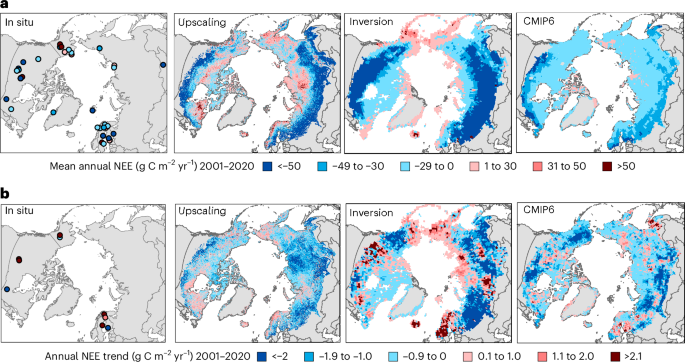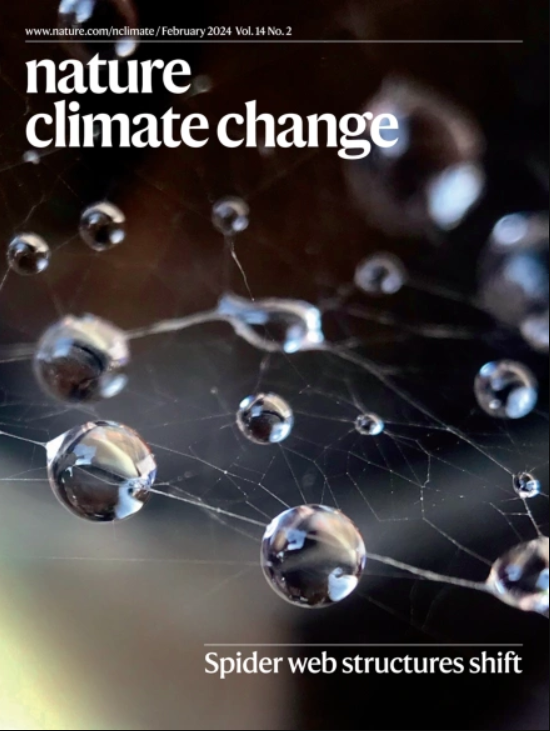Wildfires offset the increasing but spatially heterogeneous Arctic–boreal CO2 uptake
IF 29.6
1区 地球科学
Q1 ENVIRONMENTAL SCIENCES
引用次数: 0
Abstract
The Arctic–Boreal Zone is rapidly warming, impacting its large soil carbon stocks. Here we use a new compilation of terrestrial ecosystem CO2 fluxes, geospatial datasets and random forest models to show that although the Arctic–Boreal Zone was overall an increasing terrestrial CO2 sink from 2001 to 2020 (mean ± standard deviation in net ecosystem exchange, −548 ± 140 Tg C yr−1; trend, −14 Tg C yr−1; P < 0.001), more than 30% of the region was a net CO2 source. Tundra regions may have already started to function on average as CO2 sources, demonstrating a shift in carbon dynamics. When fire emissions are factored in, the increasing Arctic–Boreal Zone sink is no longer statistically significant (budget, −319 ± 140 Tg C yr−1; trend, −9 Tg C yr−1), and the permafrost region becomes CO2 neutral (budget, −24 ± 123 Tg C yr−1; trend, −3 Tg C yr−1), underscoring the importance of fire in this region. How the carbon stocks of the Arctic–Boreal Zone change with warming is not well understood. Here the authors show that wildfires and large regional differences in net carbon fluxes offset the overall increasing CO2 uptake.


野火抵消了北极-北方地区不断增加但空间异质性的二氧化碳吸收量
北极-寒带正在迅速变暖,影响了其大量的土壤碳储量。本文利用陆地生态系统CO2通量、地理空间数据集和随机森林模型的新汇编表明,尽管北极-北寒带从2001年到2020年总体上是一个不断增加的陆地CO2汇(净生态系统交换的平均值±标准差为- 548±140 Tg C yr - 1;趋势,- 14 Tg C yr - 1;P < 0.001),该地区超过30%的地区是二氧化碳净源。苔原地区可能已经开始作为二氧化碳的平均来源发挥作用,这表明碳动态的转变。当将火灾排放考虑在内时,北极-北寒带碳汇的增加在统计上不再显著(预算,- 319±140 Tg C - 1;趋势值为- 9 Tg C / yr - 1),多年冻土区变为CO2中性(收支值为- 24±123 Tg C / yr - 1;趋势,−3 Tg C yr−1),强调了火灾在该地区的重要性。
本文章由计算机程序翻译,如有差异,请以英文原文为准。
求助全文
约1分钟内获得全文
求助全文
来源期刊

Nature Climate Change
ENVIRONMENTAL SCIENCES-METEOROLOGY & ATMOSPHERIC SCIENCES
CiteScore
40.30
自引率
1.60%
发文量
267
审稿时长
4-8 weeks
期刊介绍:
Nature Climate Change is dedicated to addressing the scientific challenge of understanding Earth's changing climate and its societal implications. As a monthly journal, it publishes significant and cutting-edge research on the nature, causes, and impacts of global climate change, as well as its implications for the economy, policy, and the world at large.
The journal publishes original research spanning the natural and social sciences, synthesizing interdisciplinary research to provide a comprehensive understanding of climate change. It upholds the high standards set by all Nature-branded journals, ensuring top-tier original research through a fair and rigorous review process, broad readership access, high standards of copy editing and production, rapid publication, and independence from academic societies and other vested interests.
Nature Climate Change serves as a platform for discussion among experts, publishing opinion, analysis, and review articles. It also features Research Highlights to highlight important developments in the field and original reporting from renowned science journalists in the form of feature articles.
Topics covered in the journal include adaptation, atmospheric science, ecology, economics, energy, impacts and vulnerability, mitigation, oceanography, policy, sociology, and sustainability, among others.
 求助内容:
求助内容: 应助结果提醒方式:
应助结果提醒方式:


